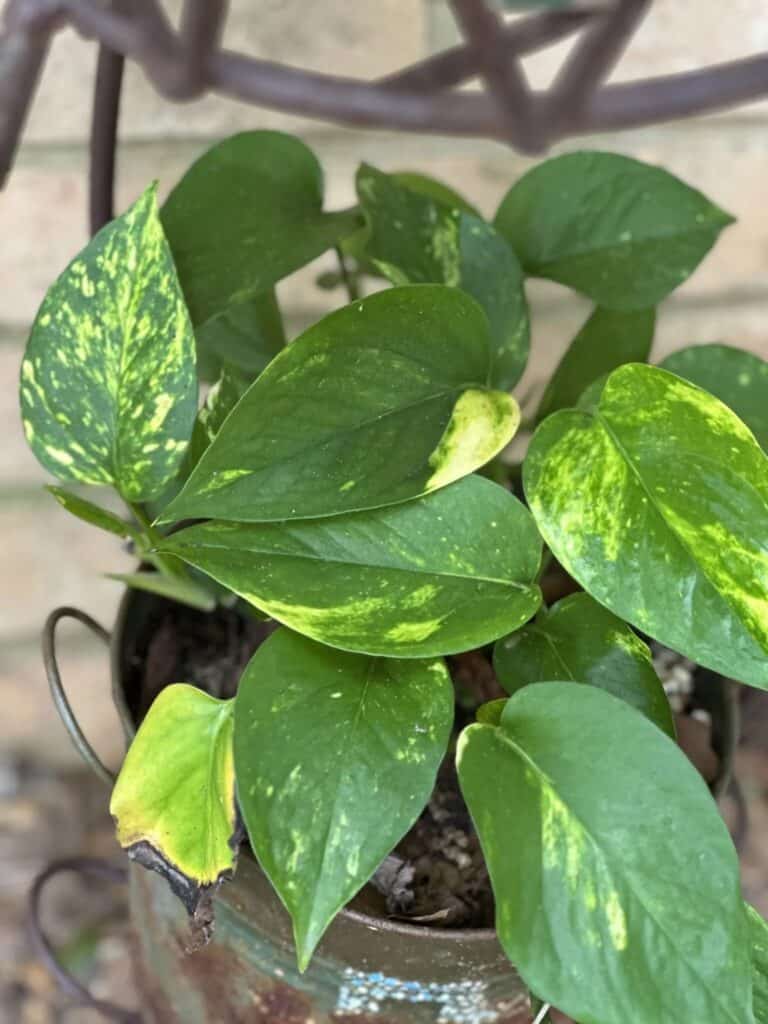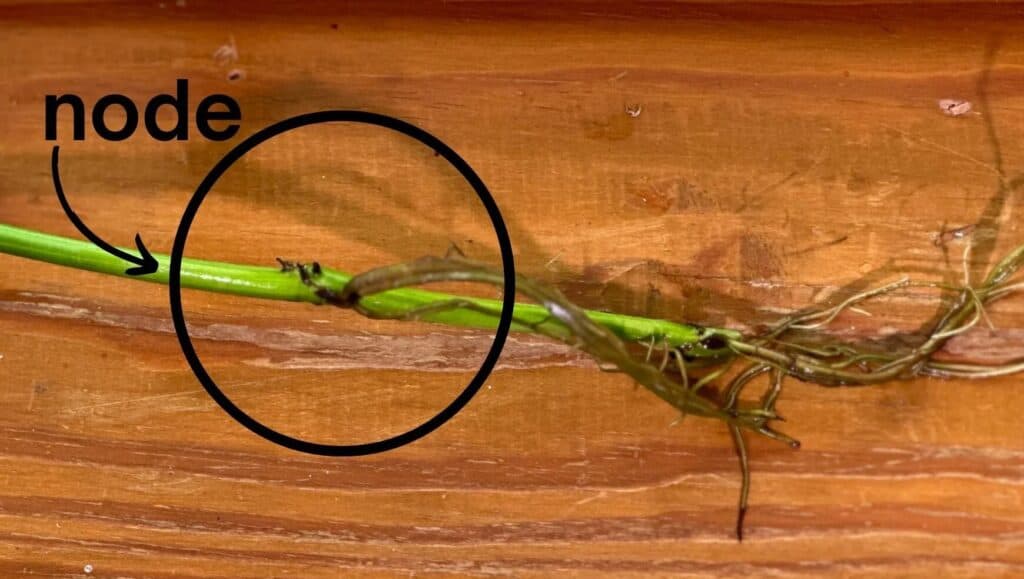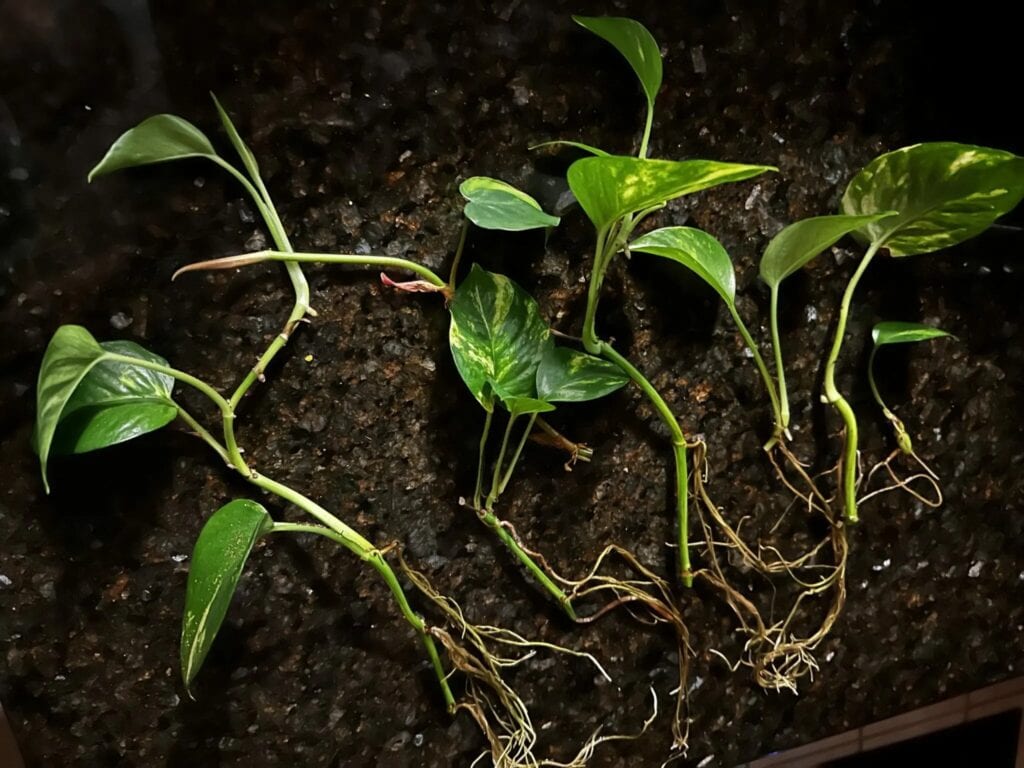The pothos is one of the most popular indoor houseplants, and it’s perfect for beginners because it’s so low maintenance. If you’re wondering how to prune a pothos and why you would, this step-by-step guide explains it all. Discover just how easy it is.

Another name for this plant is epipremnum aureum. It is also sometimes called ivy or devil’s ivy. Pothos houseplants are fast growers and easy to take care of, and they’re also usually forgiving when you forget to water them. If their leaves turn yellow from under watering or overwatering, the dead, yellow leaves are easy to pull off without damaging the plant.
The golden pothos is the most common indoor plant and the most common variety of pothos plants, but there are many more. Other pothos varieties include: neon pothos, N’joy, pearls ‘n jade, marble queen, jade, manjula, global green, snow queen, cebu blue and more.
When do you need to prune a pothos?
There is no best time for pruning a pothos. It can be done throughout the year as needed, but there are certain times or situations when pruning becomes especially beneficial.
- To control size and shape: Pothos vines can grow quite long and large over time, especially if they have plenty of light, humidity and space to grow. Pruning promotes healthy growth and helps keep the plant compact and manageable, preventing it from becoming too unruly or overwhelming its space. Pruning a pothos plant is not necessary, however, if you want to trail the vine along the wall. Simple plant clips can guide the plant and make your space look really cool.
- Encouraging fuller growth: Pruning encourages the growth of new stems and leaves, especially if you prune just above a leaf node. This can result in a bushier, more attractive plant.
- After repotting: If you’ve recently repotted your pothos, it’s a good idea to prune back some of the foliage. This reduces stress on the plant and encourages new growth.
- To refresh leggy growth: If your pothos has long, leggy stems with sparse foliage, pruning can help rejuvenate the plant by stimulating new growth closer to the base.
- Removing unwanted long vines or tendrils: Sometimes pothos can send out vines that grow in unwanted directions, like climbing up nearby furniture, for example. Pruning these back keeps the plant tidy and prevents damage.
- As part of routine maintenance: Regularly inspect your pothos for any pruning needs as part of your houseplant care routine. This proactive approach helps maintain the health and appearance of your plant.
- When there is a bug infestation or disease: This takes special care and extra steps, but you will always want to remove affected leaves and parts of the plant that are infested with bugs, such as spider mites or thrips,or have suffered disease.

How do you prune a pothos?
Pruning a pothos is quite simple, just prepare the area and take your time.
- Gather your tools: You’ll need a clean pair of sharp scissors or pruning shears. Clean them with alcohol before using to avoid spread of disease.
- Identify what to prune:
- Look for long stems that have become leggy or are trailing too far.
- Identify nodes where new growth can potentially emerge.
- Decide on your approach:
- Basic pruning: Trim back any overgrown stems or leggy growth to control the size and shape of the plant.
- Encouraging bushier growth: Prune stems just above a leaf node to encourage the plant to grow more compactly and become bushier.
- Make the cuts:
- Use your scissors or shears to make clean cuts just above a leaf node. This is where new growth will emerge.
- For leggy stems, cut back to just above a healthy leaf node to encourage new growth.
- Monitor and care for your plant: After pruning, continue to care for your pothos by providing it with appropriate light and water and occasional fertilization.
- Don’t dispose of the trimmings: Discard bug-infested or diseased plants, of course, but if you have pruned because of the length of your pothos, a leggy pothos, or just a regular pruning, save the pruned pieces for propagation and new pothos plants.

“I recommend trimming pothos between the nodes to encourage growth. You should also pull off any leaves that are yellowing.”
— Eleanor Anne, Chaos Plants
How do I propagate a pothos?
Pothos are probably the easiest houseplant to propagate. What does that mean? It means cutting a piece of the mother plant off and making new plants. Propagating can be done in water, soil, leca or sphagnum moss.
What’s fascinating about pothos is that it naturally produces its own growth hormones, which are essential for regulating various aspects of plant growth and development. So if you are propagating more than one type of plant at a time, put them in the same water as a pothos and you’ll have a naturally occurring growth hormone.
Propagating pothos in water:
Water propagation is an easy way to get those roots growing. There are many different propagation containers that you can purchase, or you can use a simple, clean small glass jar.
Materials needed:
- Healthy pothos plants and any other plants to propagate.
- Clean, sharp pair of scissors or pruning shears
- Glass or container filled with water
Steps:
- Prepare the Cutting:
- Select a healthy stem from the pothos plant that has at least two or three leaves. Make a clean cut just below a node, the point where a leaf is attached to the stem. Nodes are important because this is where roots will develop. Note that you do not need leaves to propagate a pothos, but you absolutely cannot do it without a node. If you have pruned your pothos and have many little stem cuttings, you can cut them between the nodes and propagate them all.
- Rooting in water:
- Place the pothos cuttings in a glass or container filled with water, ensuring that the node is submerged.
- Place the container in a location with indirect light and maintain the water level. Add water when the node and new roots are not submerged.
- Root development:
- After a few weeks, roots will begin to grow from the node submerged in water. You can continue growing the roots in water until they are a few inches long and well developed. New leaves will grow, too.
- Transplanting to soil:
- Once the roots are established and several inches long, you can transplant the cutting into a small pot with drainage holes and well-draining potting soil.
- Water the newly potted cutting thoroughly and place it in a location with indirect light.

Propagating pothos directly in soil
To propagate your plant in soil, simply insert the cutting into the potting soil, ensuring that the node is buried in the soil.
- Water the soil thoroughly after planting to settle it around the cutting.
- Place the pot in a location with indirect light and keep the soil consistently moist but not waterlogged.
- Roots will develop over the coming weeks. You can gently tug on the cutting after a few weeks to check for resistance, indicating that roots have formed.
With proper care, pothos houseplants can grow and thrive, making this a popular choice for beginner houseplant owners. Pruning and propagation are great ways to make your pothos fuller and improve the health of the plant, which you can also make baby pothos plants for your collection or gifting to a friend.
Gena Lazcano is the creator, writer and recipe creator at Ginger Casa. She loves her air fryer and pressure cooker and loves creating new recipes to share. She is also a self-proclaimed houseplant expert and a lover of all things garden related. She and her husband live with their three sons in East Texas.
This article originally appeared on Ginger Casa.